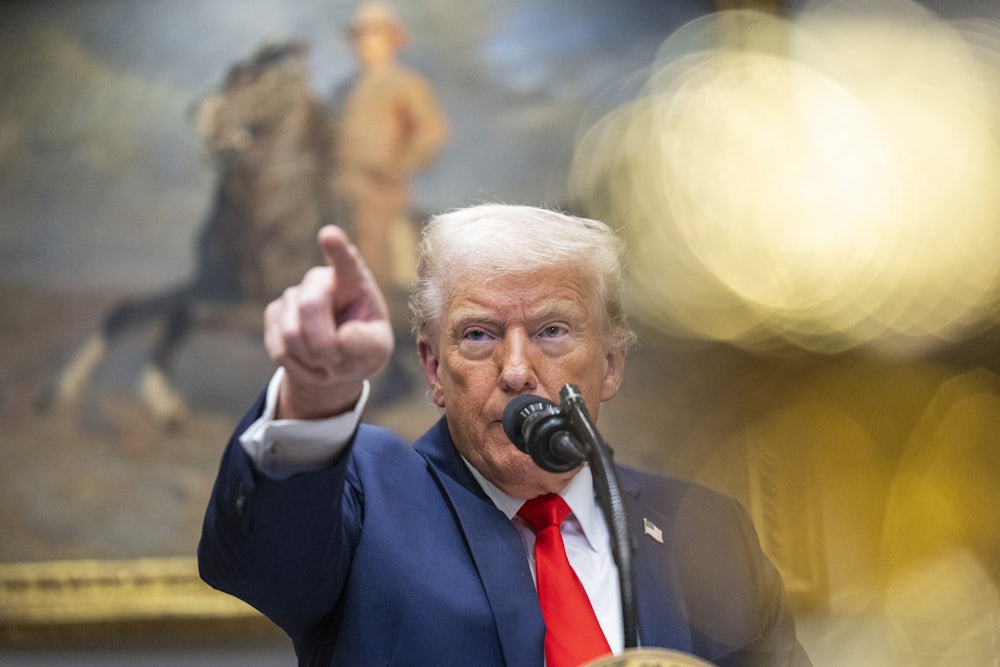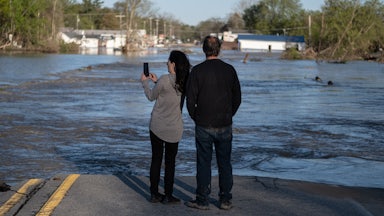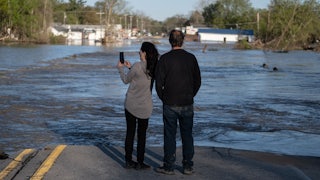Americans may wish to escape politics while on vacation, but no such luck: If you’re visiting any national monuments this summer, the Trump administration is determined to impose its cramped, totalitarian worldview on your experience. Visitors to Teddy Roosevelt National Park, in North Dakota, will see signs with a Q.R. code inviting them to report displays that are too critical of “past or living Americans” or insufficiently rapturous about the “beauty, grandeur and abundance” of the landscape.
The move stems from a May order to this effect from Interior Secretary Doug Burgum, emphasizing Trump’s orders to take action to ensure that public monuments do not contain “depictions or descriptions that inappropriately disparage Americans past or living … and instead focus on the greatness of the achievements or progress of the American people or ... the beauty abundance, and grandeur of the American landscape.” The order even encourages the public to report “any signs or other information that are negative about either past or living Americans.”
While Trump undoubtedly thinks he’s protecting Roosevelt—to whom Trump has sometimes been compared—from “woke” revisionism, this is just one in a series of this administration’s assaults on the twenty-sixth president’s legacy.
Roosevelt had considered the question of respecting the nation’s leaders—and landed in a decidedly different place than Trump. “Patriotism means to stand by the country,” he wrote in 1918. However, Roosevelt clarified, that does not mean that the president or other elected officials should be spared from criticism—quite the opposite. Of the president, he wrote, “It is patriotic to support him in so far as he efficiently serves the country. It is unpatriotic not to oppose him to the exact extent that by inefficiency or otherwise he fails in his duty to support the country.”
This surely counts as “negative” information, but Trump and Roosevelt did have much in common. Like Roosevelt, Trump is a crude imperialist dedicated to American expansionism regardless of the desires and aspirations of the rest of the world. He probably will not succeed in colonizing Greenland and Canada (or Gaza) as Roosevelt once colonized the Philippines, but his rhetoric to that effect is sincere. The men share an obsession with masculinity—their own and that of the country. (On Roosevelt’s imperialism and his cartoonish tough-guy persona, you might be surprised to find that a 2008 Yale University Press book by future senator Josh Hawley is quite good.) The two presidents also share a racist and eugenicist worldview.
But as the existence of the Theodore Roosevelt National Park—and Teddy’s comments on patriotism—suggests, that’s where the comparison ends. Roosevelt has been called the “conservation president.” He enacted the Antiquities Act of 1906, which gave him—and presidents ever since—broad leeway to declare new national landmarks and monuments. He used the law to protect six cultural areas, including Montezuma Castle, and 12 natural areas, including a huge swath of the Grand Canyon. He also doubled the number of national parks from five to 10, adding Oregon’s Crater Lake, South Dakota’s Wind Cave, North Dakota’s Sully’s Hill, Colorado’s Mesa Verde, and Platt, Oklahoma. He created 150 national forests and 55 bird sanctuaries and game preserves. In total, he protected some 230 million acres of public land.
At the 1903 dedication of the gates of Yellowstone National Park, the first-ever national park, which had been created by President Ulysses S. Grant in 1872, Roosevelt said, “Nowhere else in any civilized country is there to be found such a tract of veritable wonderland made accessible to all visitors … noteworthy in its essential democracy.” Private lands, he said, can benefit the larger community but from the standpoint of the public interest, “could never be more than poor substitutes” for national parks “created, and now administered, for the benefit and enjoyment of the people.”
That’s probably why Trump and congressional Republicans hold our public lands in such deep contempt. Why would they let “the benefit and enjoyment of the people” stand in the way of billions of dollars for the superrich? The version of the One Big Beautiful Bill Act currently being negotiated in the Senate puts hundreds of millions of acres of public lands up for sale to pay for billionaire tax breaks. Some of those targeted are popular recreation spots, hunting grounds, wildlife conservation areas, and even historic sites. The Senate parliamentarian reportedly ruled Monday that the proposal doesn’t pass muster, but in a separate move on Monday the administration announced it would open up 58 million acres of national forests for roads and development. An April poll by YouGov found that 71 percent of Americans, including 61 percent of Trump voters, oppose the sale of public lands to private bidders.
In another disturbing contrast, while Roosevelt created the Antiquities Act, Trump is working hard to weaken it by running roughshod over its curbs on executive authority and undermining its ability to protect much-cherished sites. Trump is considering abolishing some national monuments, particularly those commemorating the history of Indigenous Americans; if he does, he will be the first president ever to do that. (Congress has abolished fewer than a dozen since the Antiquities Act.) To that end, Trump’s Department of Justice issued an opinion with a highly original interpretation of the Antiquities Act, declaring that the president can get rid of national monuments as he pleases (that opinion overturns a 1938 opinion to the contrary, which stated that while Congress had some authority to abolish monuments, the president could not).
Then there’s Trump’s proposed budget, which also cuts hundreds of millions of dollars from the National Park Service this year and much more next year—as much as $1.2 billion, a 30 percent cut—angering even Republicans. The affected NPS funds support rangers, emergency responders, bathrooms, visitors’ centers, and much more. That’s not even counting the cuts and chaos that DOGE brought to the parks system, which have already reduced staff and are leading to safety problems in the parks.
Public lands, including national monuments and parks, are by definition a public good—not a private one. They are a critical part of the American commons, which we all share equally. Roosevelt believed in this ideal, but Trump emphatically opposes it. And while Roosevelt welcomed criticism of his complex presidency, Trump is attempting to shut down debate over it. Trump has just as little regard for the public sphere as he does for public lands. It is unpatriotic not to oppose him.






